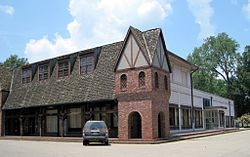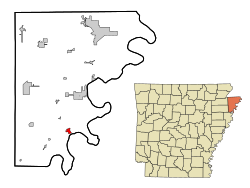Wilson, Arkansas
| Wilson, Arkansas | |
|---|---|
| City | |

Downtown Wilson
|
|
 Location in Mississippi County and the state of Arkansas |
|
| Coordinates: 35°34′4″N 90°2′37″W / 35.56778°N 90.04361°WCoordinates: 35°34′4″N 90°2′37″W / 35.56778°N 90.04361°W | |
| Country | United States |
| State | Arkansas |
| County | Mississippi |
| Incorporated | March 19, 1959 |
| Area | |
| • Total | 1.1 sq mi (2.8 km2) |
| • Land | 1.1 sq mi (2.8 km2) |
| • Water | 0 sq mi (0 km2) |
| Elevation | 240 ft (73 m) |
| Population (2010) | |
| • Total | 903 |
| • Density | 853.6/sq mi (335.4/km2) |
| Time zone | Central (CST) (UTC-6) |
| • Summer (DST) | CDT (UTC-5) |
| ZIP code | 72395 |
| Area code(s) | 870 |
| FIPS code | 05-75920 |
| GNIS feature ID | 0058899 |
Wilson is a city in Mississippi County, Arkansas. The community is located in the Arkansas delta and is surrounded by fertile cropland historically used to produce cotton. Wilson started as a company town in 1886 by Robert E. Lee Wilson, who would build a cotton empire and run it from the city. The Wilson Company would become so successful that all of the town's buildings were rebuilt in Tudor Revival architectural style following Wilson's son's honeymoon to England in 1925. Wilson did not incorporate until 1959, and remained in the Wilson family until 2010. The community has seen a rapid decline in economic activity and population since the advent of mechanization on the farm, reducing the need for manual labor to produce cotton. The population was 903 at the 2010 census.
Wilson started as a company town for Robert E. Lee Wilson's nearby logging and sawmill operation founded in 1886. The village prospered when Wilson decided to use the cleared land for agriculture instead of selling it after logging. In 1900, a major archaeological find occurred near Wilson when James K. Hampson discovered the Island 35 Mastodon. All residents of Wilson except the postmaster and railroad employees had access to company doctors for $1.25 annually ($17.92 in 2016 dollars), a rarity in the poverty-stricken Arkansas delta. The company also employed people to work in Wilson's basic service industries, such as drycleaning and automobile repair, keeping the standard of living high.
After Wilson's son, Wilson Jr., and his wife returned from their England honeymoon enthralled with the Tudor style in 1925, all subsequent public buildings were built with Tudor architecture, including retrofits to all existing public structures. The town incorporated in 1959, selling the houses to the renters living in them and gaining access to tax income it was previously excluded from as a company entity. As technology advanced on the farm, fewer employees were needed and many moved from Wilson to seek other employment.
...
Wikipedia
